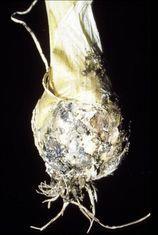
Sclerotia are durable resting structures formed by some soil-borne fungal plant pathogens which allow them to survive adverse conditions over-winter and reproduce.
When populations of sclerotia build up in the soil, disease levels generally increase, cropping becomes uneconomic and the land is often taken out of production.
At Warwick-HRI, research is currently focused on two of the most important and economically damaging soil-borne sclerotial pathogens, Sclerotinia sclerotiorum causing Sclerotinia rot and Sclerotium cepivorum causing allium white rot disease.
Sclerotia of S. sclerotiorum are large (1-10 mm) and although they reside in the soil, it is only those near the surface that germinate - when environmental conditions are favourable - to produce small mushroom-like structures called apothecia.
These apothecia then release airborne spores which can infect aerial parts of many different crop plants including lettuce, carrots, brassicas, beans and oilseed rape.
In contrast, sclerotia of S. cepivorum are smaller (0.2-0.5 mm) and germinate only in response to substances released from the roots of onion, garlic or other allium crops. The roots then become infected, resulting in plant death or the rejection of diseased bulbs at harvest.
Although these sclerotial pathogens are very different in the way they infect plants, one common approach to combat these diseases is to try and eliminate the sclerotia.
The effectiveness of conventional disease control methods such as fungicides or crop rotations to achieve this are quite limited because sclerotia often survive for long periods in the soil and are relatively inaccessible.
In addition, truly resistant crop cultivars are not available for these diseases and with an increasing desire to reduce fungicide use, alternative and more sustainable strategies are urgently required.
One such strategy is to use fungal biocontrol agents to find and destroy sclerotia.
The fungus Coniothyrium minitans is a highly specialised mycoparasite of sclerotia of Sclerotinia sclerotiorum and some other Sclerotinia and Sclerotium species.
It remains inactive in the soil until a sclerotium is introduced from infected plant material and then rapidly colonises and destroys the whole sclerotium.
Numerous glasshouse trials with lettuce over the last 15 years have demonstrated that reproducible control of Sclerotinia equivalent to that obtained with fungicides can be achieved providing disease levels are not too high.
When applied pre-planting to the soil it can be integrated with foliar fungicide applications to improve disease control even further. The potential to integrate C. minitans with other fungal biocontrol agents is also being examined.
These studies have been used as part of a registration package for a product containing C. minitans, Contans WG, which is on sale in Germany and some other countries in Europe as well as the US for control of Sclerotinia on oilseed rape and on plants grown under glass.
This product is currently undergoing registration in the UK. In addition, methods of C. minitans production and application have also been explored. Currently, the molecular mechanisms by which C. minitans destroys sclerotia are being examined with the long-term aim of enhancing biocontrol with this fungus even further.
After several years of screening and testing a large number of potential biocontrol agents, a strain of the soil-borne fungus Trichoderma viride was identified which destroys S. cepivorum sclerotia and reduces allium white rot disease.
In glasshouse tests under controlled conditions, T. viride decreased white rot by 50 to 75 per cent on onion plants but was slightly less effective under field conditions.
Nevertheless, this biocontrol agent consistently reduced allium white rot disease in three years of field trials and in some cases was as effective as the fungicide tebuconazole.
Often however, biological control using fungal mycoparasites such as T. viride may be not be as effective as using chemicals and can be more variable in their efficacy because they are affected by environmental conditions.
In order to address this, T. viride was combined with either a tebuconazole seed treatment or composted onion waste in order to try and increase efficacy and reliability of control.
The use of onion compost to control white rot was previously developed at Warwick-HRI by Professor Ralph Noble and Dr Emma Coventry.
Results showed that T. viride combined with either tebuconazole or onion compost resulted in enhanced disease control (a 90 per cent decrease in white rot) and was better than any treatment alone.
The use of such combination treatments therefore has great potential as an integrated and sustainable control strategy for allium white rot disease. Future work is aiming to look at further treatment combinations and timings, while testing the efficiency of other composts in glasshouse and field experiments. l
ACKNOWLEDGEMENTS
We would like to thank the following organisations for financial support on various aspects of this biological control work over several years: BBSRC, Defra, EU, HDC and Horticulture LINK.



